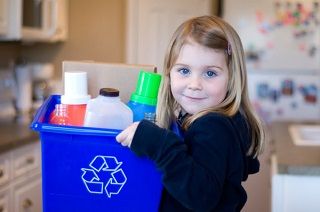From Guest Blogger Izzie: Which Household Materials Are Best for the Environment?

This has started to creep into interior design. Just as people are choosing to buy “Bag for Life” durable bags instead of plastic ones, they are also choosing materials that they believe are kinder to the environment, both in the manufacturing process and in terms of recycling.
But it can be hard to discern the environmental impact of everyday normal household materials. Some people will be willing to put the research in to find out which of two items is better, but most people simply don’t have the time. So here is a handy selection of statistics that can shed some light on some of the materials you use every day.
Wood
Wood is one of the hot button materials you’ve likely heard about your whole life. We’ve all been made acutely aware of the growing rate of deforestation in the world, so you may think that any wooden product is automatically bad. Though that may be true in most countries, many have started implementing sustainable tree farming agreements. They put roadblocks in front of the “strip mining” style of cutting down trees, and force the tree farms to be responsible with their environmental impact.
Fortunately, wood is kinder on the environment on the way out. If the wood isn’t coated in plastic or any type of heavy finish, it can decompose if left to in about 3 years. That may seem like a lot of time, but when you see other items on the list, you’ll realise this is a drop in the ocean. Plus, it is easy to recycle, owing to it’s multiple uses, and a lot of local councils have distributed separate wood (and plants in general) specific wheelie bins to make the process of separating it from your normal rubbish.
Plastic and Metal
Where these two materials are concerned, the environmental impacts related to their manufacture have more to do with the way it is produced, as opposed to where the raw materials come from. Manufacturing metal and plastic products requires a lot of power, so that contributes a lot to the burning of fossil fuels. Plus many of the products require heavy machinery.
But they decompose a lot slower than wooden products. For example, a plastic bag can take 10-20 years, but that is actually on the shorter end of the scale. Tin cans can take 80 years, and aluminum cans can take up to 200 years. But the undisputed “winner” is plastic bottles. They take a shocking 450 YEARS to decompose in the environment.
Glass
As with plastics and metals, glass’s production takes up a good amount of power, but due to it’s fragile nature, heavy machinery isn’t in as wider use. But in terms of decomposition, it is in a league of it’s own. A glass bottle will take 1 MILLION YEARS to decompose naturally. That’s unreal.
But don’t let that put you off – it’s actually one of the best materials to recycle, due to it being made entirely of sand, just as it was hundreds of years ago when it first started to be manufactured. So if you are careful with it, and dispose of it responsibly, you won’t be responsible for a million year long process!
